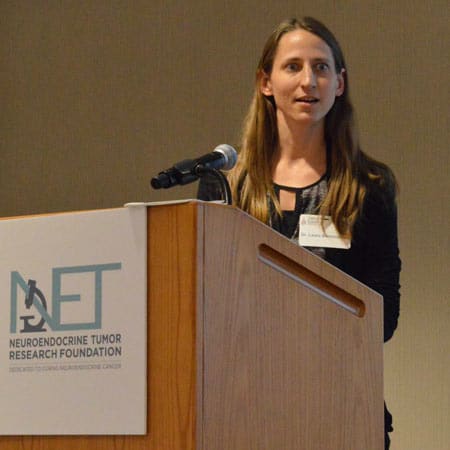
The role of ATRX/DAXX/H3.3 chromatin regulation in pancreatic neuroendocrine tumors
Laura Banaszynski, PhD, has always been passionate about science. After training as a chemical biologist, her innate curiosity pushed her to explore the mysteries of cells as a basic researcher.
Her face lights up when she talks about chromatin biology. She is fascinated by the proteins ATRX/DAXX/H3.3, which are involved in the development of NETs. In April, she was awarded the 2017 NETRF Petersen Investigator grant, allowing her to devote half of her University of Texas laboratory’s resources to understanding this signaling or “communication” pathway. NETRF’s Petersen Investigator Award is made possible by a generous gift from the Margie and Robert E. Petersen Foundation, to reduce the medical mystery of this disease.
Looking at cellular communication
Recent studies have identified several genes that are commonly mutated in pancreatic NETs. A mutated gene can send the wrong instructions to cells. By looking at and understanding how a genome’s message is unpacked, what signals it sends to cells, and how cells interpret these signals to activate signaling pathways, we can find ways to cut off misdirected, cancer-causing cellular communication.
Dr. Banaszynski’s research will examine how cells identify and use instructions about their functions. “One of the things that goes wrong when cells start using the wrong piece of information is that you can develop cancers,” she said.
Intercepting the wrong instructions
The goal of Dr. Banaszynski’s project is to understand the role of ATRX/DAXX/H3.3 in sending messages to cells.
- How do these proteins get to their targets?
- How do these proteins know where to go?
- How do they stand out in a crowd?
- Do they have a signaling system?
- Is there a response to the signaling system?
If we understand these cellular signaling pathways and how they are controlled by these genes, we can interrupt the network to prevent tumors.
About Laura Banaszynski, Ph.D.
Laura Banaszynski, Ph.D., is an assistant professor in the Department of Obstetrics and Gynecology, Children’s Research Institute, at UT Southwestern Medical Center. She is a member of the Cecil H. and Ida Green Center for Reproductive Biology Sciences and a Virginia Murchison Linthicum Scholar in Medical Research. Dr. Banaszynski received her B.S. in chemistry from The University of Notre Dame, and her Ph.D. in chemical and systems biology at Stanford University. She was a Damon Runyon postdoctoral fellow at The Rockefeller University.



